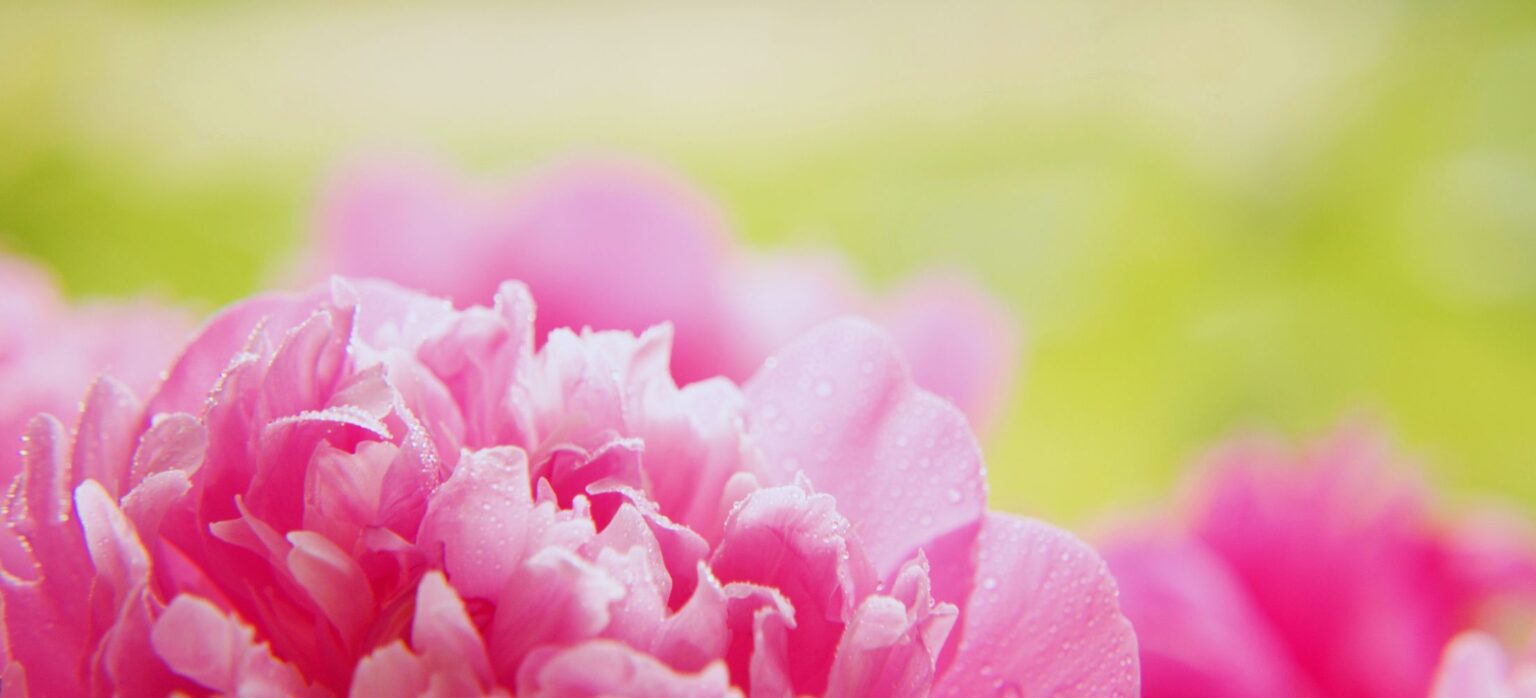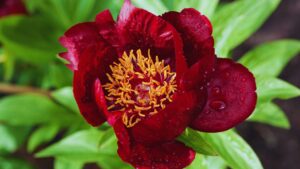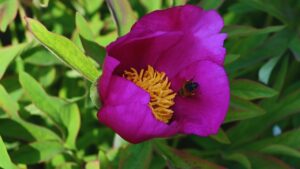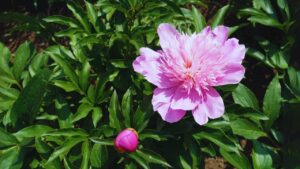Introduction
The flowering plant peony exists as one of the most beautiful long-lived varieties because of its lush foliage and rich fragrant blossoms. Garden plots enhance peonies because these plants bring stunning color along with delightful garden appearance.
Gardeners who maintain suitable maintenance strategies along with optimal growing environments will be able to allow peonies to survive for generations while offering yearly magnificent blooming seasons.
This guide provided full details about peonies cultivations including their species information alongside planting advice and management tips to handle pest problems and disease prevention.
What Are Peonies?
Perennial flowering plants within the genus Paeonia are known as peonies. The plants earn fame through their beautiful flower display that emerges between late spring and early summer. Gardeners universally choose these plants because they live extensively without requiring much upkeep.
Beside their decorative value, peonies are preferred by gardeners because they create gorgeous lasting displays throughout the garden spaces. People who garden at any level find peonies as an outstanding choice because they offer durability that lasts.
Types of Peonies
The different peony varieties exhibit distinct features among their forms. The main types include:
Herbaceous Peonies
Most of these peonies wither to the earth during winter before rising again in spring. Each plant has firm stalks that support their dramatic large blossoms. Plant growers choose peonies as their main garden flower because they thrive easily and produce gorgeous flower colors from white to pink to red to yellow.
Tree Peonies
Tree peonies differ from herbaceous types because they retain woody wood stems which persist throughout every season. They are typically produce flowers earlier than other kinds and these blooms reach larger sizes. Gardeners who invest additional care into these types of peonies will receive extraordinary flowers that establish an elegant look in their garden space.
Itoh (Intersectional) Peonies
These crossbreeds unite vital characteristics from standard varieties with the ones from tree-based types. The plants possess durable stems which grow large flowers during extended blooming seasons. These plants have become popular choices among gardeners because they show attractive displays under all weather types.
When and Where to Grow Peonies
Best Time to Plant Peonies
Planting of peonies should take place during the fall season from September until early November. The roots benefit from this planting season because they can build strength before winter dormancy starts which produces bigger and better blooms in spring.
Peony planted during fall suffer less transplant trauma since they obtain an extended period to develop robust underground roots prior to warmer climate onset. Plant peonies early during spring before any fresh growth emerges since fall represents the best season for optimal outcomes.
In regions with frosty winters growers should plant peony six weeks before cold temperatures freeze the earth to allow roots to develop successfully. Peony growing in moderate winter climates should be planted under partial shading which shields them from hot environmental conditions.
Ideal Growing Conditions for Peonies
Excellent peony growth relies on meeting these three growing conditions.
Sunlight
Peony will thrive in conditions with at least six to eight hours of direct sun each day since they demand full sunlight for their proper growth.
Plants need a brightly sunlit location for optimal blooming performance and to stop the development of weak and stunted growth. The growth of peony will occur in shade conditions but their flowering capability will decrease.
Soil
Peonies need to grow in well-draining fertile ground that maintains a pH between 6.5-7.5 which is slightly acidic to neutral. Soils consisting of heavy clay require addition of compost and organic matter because this improves drainage conditions.
Sandy surfaces should receive organic additives to boost their moisture retention as well as their nutrient absorption.
Spacing
To stop diseases like powdery mildew and botrytis blight from developing peony need proper ventilation between the plants. Plants should be spaced 3 feet apart for proper airflow because this distance decreases the chance of fungal infections.
Temperature and hardness
Peony in USDA Zone 3-8 are hardy. They need to bloom properly to the period of inactivity of winter, making them well suited to temperate climate. In warm areas, planting peonies in partially shaded areas can help protect them from excessive heat stress.
How to grow peonies
Step 1: Preparation of soil
Choose a planting site in contact with good sunlight. To improve fertility, enrich the soil with manure, old manure, or organic matter. Ensure proper drainage to prevent root rot, as peony do not tolerate standing water.
Step 2: Planting
Dug a hole about 12–18 inches deep and wide. Place the root crown below the surface more than 1-2 inches deeply, as deep planting can prevent bloom. Fill the holes with the soil, press firmly around the roots to eliminate the air pocket. Water well after planting to help install the roots.
Step 3: Peonies Care
Water: I always Keep the soil continuously moist but no waterfall. Peony require deep water, especially during dried mantra.
Mulching: Apply a layer of organic wet grass to maintain moisture and suppress weeds.
Fertilization: Use a balanced fertilizer (10–10–10) in early spring and after blooming to promote healthy growth.
Stacking: Support long varieties to prevent stems from bending under the weight of your large flowers.
Fellow plants for peonies
Pearring garden enhances beauty and supports plant health with perfect fellow plants. Some great options include:
- Lavender: Helps prevent insects and provides contrast in color and texture.
- Alliums: Their strong fragrance overtakes Aphids and other insects.
- Irises: They bloom around the same time and add diversity to the garden.
- Salvia: attracts pollinators, which benefits flower production.
- Columbins: Offer beautiful leaves and complement the flowers thoroughly.
Incorporating Peonies into Your Garden Design
Peonies can enhance any lawn with their lush blooms and attractive foliage. Here’s the way to apply them successfully on your panorama.
Companion Planting: Pairing Peonies with Complementary Plants
- To create a harmonious and visually appealing lawn, don’t forget pairing peonies with flora that complement their boom conduct and flowering instances.
- Spring-blooming bulbs which include tulips and daffodils add early-season shade before peonies take their middle diploma.
- Late-blooming perennials like delphiniums and phlox can amplify the flowering season and offer continuous garden hobby.
- Ornamental grasses offer a setting textural evaluation to peonies’ lush foliage and might create movement in the garden.
Using Peonies in Different Landscaping Styles
Peonies are fantastically flexible and can be blanketed into several garden designs.
- As appealing focal factors in mixed perennial borders, they provide pinnacle, texture, and coloration.
- In formal garden settings, peonies create elegant and mounted suggestions.
- When planted as basis plantings, they soften the arrival of homes and walkways.
- In cottage gardens, peonies mixture fantastically with a mixture of old fashioned flora like roses and hollyhocks.
- Tree peonies, specifically, thrive in large packing containers and make superb specimen vegetation on patios or entryways.
Caring for Peonies Throughout the Seasons
Peonies require one in every kind of a kind of variety of care counting on the time of 12 months. Understanding their seasonal goals will assist in preserving them healthy and thriving.
Spring: The Season of New Growth
- As peonies emerge from dormancy, apply a balanced fertilizer to assist a healthful boom.
- Install plant supports early to save you heavy blooms from drooping.
- Keep an eye fixed out for pests and fungal illnesses and take preventive movement if wished.
Summer: Enjoying the Peak Bloom Period
- Relish the sight of colourful peony blooms inside the lawn.
- Remove spent plants (deadheading) to maintain a tidy appearance and inspire root improvement.
- Continue watering continuously, in particular in the course of dry spells, to prevent strain on the flora.
Fall: Preparing Peonies for Dormancy
- As temperatures drop, peony foliage starts off, evolves to yellow and dies again. This is a herbal part of the plant’s cycle.
- If wanted, divide and transplant herbaceous peonies to rejuvenate antique plants or amplify your series.
- Once the primary frost arrives, reduce again the stems of herbaceous peonies to about 2 inches above the floor.
- Fall is likewise the terrific time to plant new peonies, permitting them to set up roots earlier than wintry weather.
Winter: Peonies Enter Dormancy
- During wintry weather, peonies rest underground, keeping electricity for the subsequent developing season.
- Tree peonies, which preserve woody stems, can also moreover need protection from heavy snow accumulation to prevent breakage.
- Use this time to plan for ultra-modern additions to your garden and order bare-root peonies for spring planting.
Common pest and disease
While peony are usually hardy, they can suffer from some insects and diseases.
- Normal insect Aphids: Small insects that feed on the sap of the plant. Control them with pesticides soap.
- Thrips: The cause of disappointed, damaged petals. Neem oil or pesticide sprays help reduce their number.
- Ants: Although not harmful, they are often attracted to buds.
General disease
1. Botrytis Blight (Gray Mold)
Botrytis blight is a common fungal disorder that affects peonies, especially in cool and damp climate situations. It causes buds to turn black and fail to open, stems to turn out to be inclined and wilted, and gray mildew to develop on leaves and stems. If left untreated, this disorder can spread all at once, leading to bad plant fitness and reduced blooming.
Solution:
Pruning: Regularly take a look at your peony plant life for inflamed buds, leaves, or stems. Cut off any diseased parts of the usage of sterilized lawn shears and put them away from the lawn to prevent the fungus from spreading.
- Air flow: Peonies need to be spaced at least 3 feet aside to allow precise airflow. Poor movement will increase humidity, which favors fungal increase. If needed, prune surrounding vegetation to improve air float.
- Sanitation: In the autumn, get rid of vain leaves and plant particles round peonies, as those can harbor fungal spores in order to reinfect the plants in spring. Keeping the garden bed easy reduces the probabilities of reinfection.
- Fungicide: Apply a fungicide containing copper or chlorothalonil early in the developing season, mainly at some stage in wet weather. Reapply as directed to maintain the disease underneath control.
2. Powdery Mildew
Powdery mold is a fungal contamination that appears as a white, powdery coating on peony leaves, often beginning in the overdue summer season. It can weaken the plant, lessen photosynthesis, and negatively impact flowering. While it does not often kill the plant, excessive instances can cause premature leaf drop and terrible plant vigor.
Solution:
- Air stream: Ensure right spacing between plants and prune excess foliage to allow higher airflow. Poor ventilation encourages fungal boom.
- Watering: Avoid overhead watering, as moist leaves sell fungal infections. Instead, water at the lowest of the plant early inside the morning so that any moisture on leaves dries short.
- Treatment: At the number one signal of powdery mildew, spray affected regions with neem oil, sulfur-based totally completely fungicides, or a homemade baking soda answer (1 teaspoon baking soda in 1 quart of water). Repeat packages can be important for effective control.
3. Ants on Peony Buds
Peony buds produce a sweet nectar that without a doubt draws ants. Many gardeners mistakenly accept as real that ants assist peonies bloom, however they without a doubt feed on the nectar without affecting the flowering process. While they’re no longer dangerous to peonies, their presence can be bothersome.
Solution:
- Leave them by myself: Ants no longer harm peonies and will manifestly go away as soon as the flowers bloom. They are part of the plant’s environment and pose no real danger.
- Hose them off: If ants come to be too numerous, you can lightly spray the buds with water to clean them away. This needs to be executed in the early morning so the plant can dry out fast.
- Do not use insecticides: Chemical insecticides are vain due to the reality that ants do not now harm peonies. Using pesticides can disrupt the herbal balance and kill useful bugs in the lawn.
4. Peony Leaf Spot (Cladosporium or Phyllosticta)
Peony leaf spot is a fungal sickness that causes darkish purple, reddish-brown, or black spots to appear on leaves. Over time, those spots might also additionally enlarge, fundamental to untimely yellowing and leaf drop. Severe infections can weaken the plant and have an impact on blooming the subsequent season.
Solution:
- Sanitation: Remove inflamed leaves and smooth up fallen debris across the plant to save you fungal spores from overwintering and spreading inside the subsequent season.
- Watering: Water peonies at the lowest instead of overhead to keep the foliage dry. Moist leaves offer an incredible environment for fungal infections.
- Fungicide: Use a copper-based fungicide or sulfur spray at the first sign of contamination. Apply every week till symptoms subside.
5. Peony Wilt (Phytophthora Blight)
Peony wilt is an extreme fungal sickness that can purposely stem to abruptly disintegrate, flip black, and die. It spreads fast in moist, poorly drained soil and may kill a whole plant if not controlled. Infected flora may display stunted growth and fail to bloom properly.
Solution:
- Remove infected plants: If a plant is significantly affected, remove it right away, such as the roots, and get rid of it properly to save you the sickness from spreading to other peonies.
- Improve drainage: Peonies thrive in nicely-drained soil. If your soil retains an excessive amount of moisture, consider adding sand, compost, or perlite to beautify drainage, or plant peonies in raised beds.
- Fungicide: Apply a fungicide labeled for Phytophthora if signs and symptoms are observed early. Preventative remedy in early spring also can help shield plant life from infection.
6. Failure to Bloom
Peonies are prized for his or her large, lovely blooms, so after they fail to flower, it can be disappointing. Several factors can make a contribution to this trouble, along with incorrect planting depth, inadequate daylight, younger plants, or immoderate nitrogen fertilization.
Solution:
- Planting depth: Peonies must be planted shallowly, with the “eyes” (buds) satisfactory 1-2 inches underneath the soil floor. If planted too deep, the plant may additionally produce lush foliage however fail to bloom. If important, raise and replant peonies at the ideal depth inside the fall.
- Sunlight: Peonies require as a minimum 6 hours of complete sun each day to bloom nicely. If your peony is in an excessive amount of colour, consider transplanting it to a sunnier spot inside the garden throughout the dormant season.
- Age of plant: Newly planted peonies can also take 2-three years to mature and bloom constantly. Be affected by people with extra youthful flowers as they install themselves.
- Fertilization: Avoid making use of excessive nitrogen, as it promotes lush foliage boom at the fee of plants. Use a balanced fertilizer, or one barely better in phosphorus (which includes 10-20-10) to inspire blooming.
7. Root Rot
Root rot is a not unusual trouble in peonies developing in poorly drained or overly moist soil. It reasons the roots to emerge as gentle, mainly to yellowing leaves, stunted growth, and eventual plant death.
Solution:
- Improve drainage: Ensure that your soil is nicely-draining and keep away from planting peonies in regions prone to popular water. If important, mix in compost, perlite, or sand to decorate soil drainage.
- Avoid overwatering: Peonies pick deep however rare watering. Allow the soil to dry out slightly among watering instructions to prevent excessive moisture buildup.
- Remove affected flowers: If root rot is intense, do away with and discard inflamed plants to prevent the ailment from spreading. Treat the soil with a fungicide in advance than replanting in the same place.
8. Leaf Burn (Scorch)
Leaf scorch occurs at the same time as peony leaves turn brown or broaden crispy edges, commonly because of immoderate heat, sturdy winds, or insufficient watering. While it doesn’t generally kill the plant, it may weaken it through the years.
Solution:
- Watering: Peonies want deep, regular watering, particularly during heat, dry spells. Water at the lowest of the plant within the morning to help it preserve moisture all through the day.
- Mulching: Apply a 2-inch layer of mulch around the base of the plant to help conserve soil moisture and shield the roots from intense temperatures.
- Shade safety: If peonies are uncovered to extreme afternoon solar, undergo in thoughts supplying brief colour using a lawn fabric or nearby plant life to guard them from extreme warmness.
Conclusion
Growing need to successfully select the right variety, planting at the right time and provide proper care. By ensuring good soil conditions, regular maintenance and prevention of disease, you can enjoy their stunning bloom for years.
Whether alone or with fellow plants, these flowers are a timely addition to any garden, bringing the season of beauty and elegance after the season.









